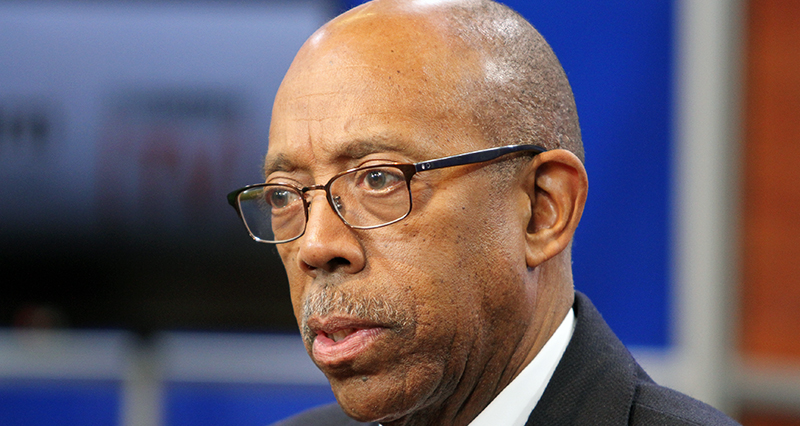
OSU president Michael Drake spoke to Lantern staff members on March 8 about the upcoming year and campus-wide issues and progress. Credit: Samantha Hollingshead | Photo Editor
University President Michael Drake has had a busy first semester in what he refers to as his “sophomore year.” From security incidents to traditions in jeopardy, the president has had to deal with heavier issues in his second year at Ohio State.
On Tuesday, Drake sat down with The Lantern staff to discuss what the administration is doing to improve its security measures, ensure the success of humanities majors, make OSU affordable and more.
Safety and security
In light of an incident at the Wexner Center on Nov. 29 during which a former OSU security officer entered a gallery and vandalized artwork before taking his own life, Drake said OSU is working to improve its emergency messaging.
“I didn’t think that the communication was effective at the Wexner,” Drake said. “We’ve talked about that, and we’ve actually used that to try to refine and revise our policies and procedures so that they are effective.”
Drake said some specific recommendations have been presented to the Board of Trustees and some changes have been made. However, the university president added that some cannot be shared for security reasons.
“So part of the deal is that you don’t talk about exactly what your security is because then if someone wishes to get around it, they know exactly what you’re doing,” he said.
But he did share that the university has revised the notification criteria in an effort to get alerts out more quickly when there’s something that “needs to be avoided or should be avoided.”
Drake noted that this can be difficult because these tragedies often happen in a short time span.
“They’re often over as soon as they start … they’re a few minutes, so by the time you’re able to kind of get around to notifying people, then it’s already done,” he said.
Drake explained that the university’s first response is to dispatch public-safety officials to “help control the situation.” The next step, he explained, is to send out a timely warning.
“Sometimes, the notifying and getting the public safety responders there happens, and then they’re there so quickly that by the time you have taken a look again at what’s happening and it’s time to put out the warning … there’s nothing to warn about anymore,” he said.
Drake said the university’s goal is to send out warnings while also balancing gathering information and getting public-safety officials to the scene when incidents occur.
President Drake also emphasized the importance of students staying safe while participating in university traditions. Following the tragedy of Austin Singletary’s death as a result of injuries the third-year in human nutrition sustained during the Mirror Lake jump, Drake said the university is waiting to hear the outcomes of students’ discussions to find an alternative tradition for next year.
Drake said he understands the importance of traditions but wants to ensure the well-being of students.
“I care about each and every (student), and I want to do everything we can to make sure (they) have a wonderful experience and stay safe,” he said.
Why humanities matter
Last month, The Lantern reported about a decline in enrollment for humanities majors.
Though Drake comes from a medical background, as he was an ophthalmologist specializing in glaucoma before taking on the role of university administrator, Drake emphasized the importance of promoting both humanities and STEM fields.
“I see that our responsibility as a comprehensive university is to support all points of inquiry,” Drake said.
He added that the undergraduate seminar that he is teaching this semester falls under humanities.
“I believe very much that humanities are a critical part of what we do as a university,” Drake said. “Humanities, social sciences, the arts, all of those things that talk about who we are and how we interact with each other are critically important to what it means to be human.”
After moving from quarters to semesters and a few other changes, Drake said OSU’s budget model “tended to maybe have some rough spots that (they) hadn’t expected, so (they’re) looking at those to make sure that (they) don’t penalize humanities and others in a way that (they) didn’t mean to.”
College affordability
Drake also touted OSU’s increase in funding of affordability grants. Funding of the grants is set to rise $5 million, bringing next year’s total to $20 million.
Drake noted that OSU put itself on the line last year in saying it would provide $15 million in affordability grants before it knew where the money would come from.
“And next year we are going to do ($20 million). That’s really to help decrease the burden of college education on lower- and middle-income families, where it can be stifling,” he said.
As for out-of-state student costs, Drake said OSU is “still a great bargain.” The president reinforced the importance of having these students, citing the diversity of opinions and experiences they bring to OSU.
According to OSU’s statistical summary, during Autumn 2015, there were 17,073 non-Ohio students enrolled and 6,148 foreign students enrolled at the Columbus campus.
Drake said he thinks OSU’s balance of in-state and out-of-state students is good.
“We have had an incredible number of students come from out of state, and they make us extremely strong, and that’s a good thing,” he said. “And we’re still providing an opportunity for thousands and thousands of Ohio students, which is our primary responsibility.”
Ashley Nelson, Kevin Stankiewicz and Jay Panandiker contributed to this story.


